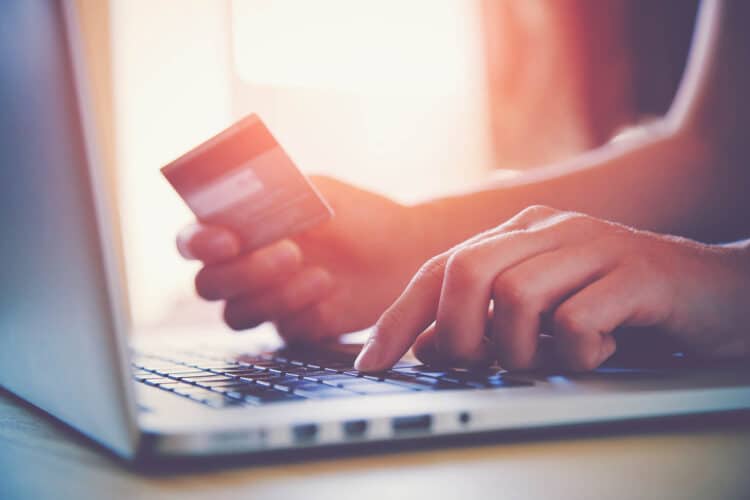On September 2, 1969, the first automatic teller machine (ATM) debuted in New York. It served customers at Chemical Bank in Rockville Centre.
Since then, ATMs have gone on to revolutionize the entire banking industry. The services this equipment offers often eliminate the need to visit a bank or credit union to conduct everyday financial transactions.
Many people use ATMs to deposit or withdraw money. Most deposits are available the next business day, while cash is dispensed for immediate use. A small fee often applies, but this amount is usually waived.
One of the most under-utilized tools an ATM offers is the ability to pay your monthly credit card bills.
How Can I Pay My Credit Card Bill Through an ATM?
The best way to pay a credit card balance at an ATM is to insert the card into the machine. Cash payments require users to visit an issuer’s branch for a successful result. On the screen, choose the payment option and follow the instructions to transfer funds to the current balance. Review the receipt to ensure the amount sent is accurate.
To pay your credit card bill through an ATM, follow these steps for a successful outcome.
- Insert your credit card into the ATM machine and enter your personal identification number (PIN).
- Select “Bill Payment” or “Credit Card Payment” from the options displayed on the screen.
- Choose the credit card company receiving the payment, and then enter your credit card number when prompted on the display.
- You will receive an ATM request to enter the amount you wish to pay. Type this amount to continue.
- The ATM will then ask you to confirm the payment details. Double-check the information, and if it’s correct, press the “OK” button to complete the transaction.
- The ATM will dispense a receipt confirming your payment.
Before making a payment, ensure that you have enough funds in your bank account to cover the amount you’ve requested to send to the credit card issuer. If you don’t have enough funds, the payment will not go through, and you may incur fees.
What Happens If the ATM Doesn’t Provide a Correct Transaction?
If the ATM doesn’t calculate your cash correctly, the first thing you should do is contact your bank or credit card company immediately to report the issue.
You should provide as much detail as possible, including the location and time of the transaction, the amount of money you wanted to transfer to the credit card issuer, and any error messages or receipts that you received.
In most cases, your bank or credit card company will investigate the issue and work to resolve it. They may put a temporary hold on your account or issue a refund for the incorrect amount. Depending on the severity of the problem, they may also escalate the matter to the ATM operator or network for further investigation.
It’s important to act quickly if you suspect that an ATM has not calculated your cash payment correctly. The longer you wait, the harder it may be to resolve the issue.
Should I Pay My Credit Card with Cash at an ATM?
You should pay off a credit card balance or make the monthly minimum payment with cash at an ATM if that option makes the most sense for your needs.
In some situations, making a cash payment is the best option for many people. Here are some of the times when it is sensible to use this method to manage your obligations.
- Internet Outage. Experiencing a connection issue, including Internet and data access, can make it hard to meet a payment deadline when the problems develop on the day the money is due. Traveling to an ATM at a local branch to pay with cash ensures that everything is paid for on time.
- You Get Cash. Some workers receive cash payments for performing their job duties, such as servers. Having the option to pay some or all your credit card bills from these earnings is convenient, allowing you to skip the teller and the time it takes to access banking services.
- Budget Needs. Some people use cash for budgeting purposes to ensure they don’t exceed monthly limits. The easiest way to collect what is owed for a credit card payment over the month is to pay the balance with currency at the ATM, reducing the time it takes to make multiple digital transfers or deposits.
- Unbanked. If you don’t have a bank account to use for sending money to a credit card, the next best option could be to pay in cash at the ATM to maintain on-time payments.
The best solution is to pay off the full balance of a credit card whenever possible when making cash payments at the ATM. This step improves your credit score while helping to keep more money available in the long run.
What Are the Benefits of Paying Off a Credit Card?
When you have an opportunity to pay off a credit card, several benefits can start coming your way. Although that means you might pay more in the short term to take control of your finances, you’ll often save thousands of dollars in interest payments.
Here is a closer look at why making cash payments at ATMs can help you achieve debt freedom and get rid of those credit card balances once and for all.
Improve Your Credit Score
Paying off a credit card balance can improve your credit score. Your utilization ratio, which is the amount of credit you’re using compared to your limit, is an essential factor in the results that reflect your overall financial profile.
If you pay off your credit card, your utilization ratio will go down, which can improve your credit score.
A good credit score generally falls within the range of 670 to 739 on the FICO® scale, which is one of the most widely used scoring models in the United States.
What constitutes a good credit score can vary depending on the specific lender or credit bureau, as well as the type of credit product for which you’re applying.
The higher your score, the more likely you are to be approved for credit and to receive favorable terms, such as lower interest rates and higher limits.
Reduce Personal Stress
Carrying credit card debt can be stressful, especially if you need help to make your monthly payments. Paying off your monthly balances helps to reduce that stress and deliver a sense of financial freedom.
Debt can create a financial burden that can be difficult to manage. When you owe money, you may struggle to make payments on time, which can lead to late fees and interest charges. This activity can create a cycle of debt that can be difficult to break.
For some people, having debt creates pressure to perform at work or in other areas of their life to meet financial obligations.
Increase Available Credit
When you pay off a credit card, you free up available credit that you can use in case of emergencies or to make larger purchases. It allows you to use your other financial resources while taking care of your debt obligations by using cash at the ATM.
Although there isn’t a set amount of available credit that is “good” for everyone, the amount you have should be under 30% of what is available. If you have a total credit limit of $50,000, you will want to keep your balances below $15,000.
It’s generally a good idea to have a mix of different types of credit accounts, such as credit cards, loans, and lines of credit. This structure helps to diversify your profile and improve your score over time.
Improved Financial Health
Paying off a credit card is a significant step toward improving your overall financial health. It shows that you’re responsible with your money and that you’re taking steps to reduce your debt and improve your credit score.
How Much Cash Can an ATM Take for a Payment?
The amount of cash an ATM can take for a payment varies depending on the specific ATM and the bank or financial institution that owns it.
Most ATMs have a limit between $200 to $500 for each transaction. When making a cash payment on a credit card with this method, it’s essential to check the limits before putting money into the machine.
You might need to make multiple transactions or visit the bank in person to make a payment that exceeds what the ATMs allow. Be sure to check for any applicable fees or charges and factor them into the total amount of what you eventually deposit.
If your goal is to pay the monthly minimum due, your cash deposit at an ATM would need to include any fees associated with that transaction to ensure the correct amount gets transferred to your debt.
The institution takes out the fees before transferring the money according to the instructions you’ve created on the machine.
Is It Worthwhile to Pay Credit Card Bills at ATMs?
Paying a credit card obligation at an ATM is not a universal feature across all lenders and issuers, but it is more common now than in 2010 or before. Chase, Bank of America, U.S. Bank, Wells Fargo, and Capital One allow these payments. These machines do not usually give change, so the total amount deposited becomes the payment.
I worked as a waiter part-time in college to help pay some bills and live in my own apartment off-campus. After spending the first half of the year in the dorms, I was ready for something more independent.
I can remember hurrying down the street toward the ATM at the bank at the end of my blog. It was the first of the month, and I needed to make a payment. Thankfully, my credit card was issued by the bank where I had my checking and savings accounts. After fishing my card out of my wallet and inserting it into the machine, I inserted my PIN and went through the menus to fulfill my payment obligations.
That time went well, but it wasn’t always smooth. The ATM wasn’t always available, so I’d have to rush inside before the branch closed for the day to make the payment with a teller.
I’ve moved on to using apps for most of my payments because of how quick and easy it is, but that option isn’t for everyone. Going to an ATM with cash makes sense in many cases, which I know from personal experience.


